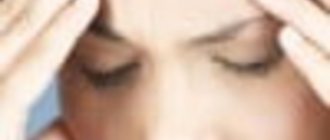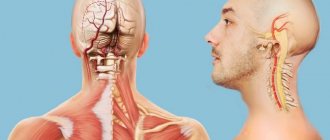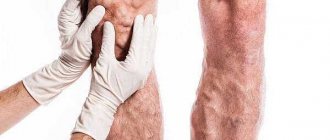An occasional headache is familiar to all people, since it can appear as a consequence of ordinary fatigue or the body’s reaction to changes in meteorological conditions. Usually this condition does not require medical intervention and stops on its own, you just need to rest a little or wait for the weather to change. However, constant pain in the temples, forehead or eyes is a clear reason to think about the state of your own health, since regular pain in the head (chronic cephalgia) can be one of the symptoms of a serious illness.
Causes of headaches
Insufficient time for rest, nervous stress, city noise, and an overly intense rhythm of life are often the root causes of constant headaches. If the cause of stress or discomfort is eliminated for a certain period of time, your health will improve significantly. While persistent cephalgia may be a sign of a serious disease that requires medical intervention:
- allergy;
- high intracranial pressure caused by vascular diseases;
- migraine accompanied by nausea, sound and light sensitivity;
- hematomas in the head caused by injury;
- tumor formations;
- aneurysms;
- the presence of inflammatory foci in brain tissue;
- nasal congestion, infectious diseases of the respiratory system;
- critical days of the menstrual cycle or pregnancy;
- damage to the trigeminal nerve.
Chronic headaches in the temporal region and forehead with osteochondrosis of the cervical spine, as a rule, are chronic. This is a consequence of pinched vessels supplying the neck and irritation of the nerve endings. After the underlying disease is cured, the patient’s well-being improves. If no other reasons related to physiology can be traced, the whole issue may be a disorder of the vegetative-vascular system.
Non-hazardous conditions
Cephalgia often manifests itself during pregnancy, often at the beginning, as a result of hormonal imbalance, a drop in immune defense occurs, and the emotional reaction becomes difficult to control. Women are often under mental stress, feel pressure drops, forgotten chronic diseases appear, and catch a cold.
These reasons influence the appearance of pain in the temples and forehead, which has an aching, squeezing nature. The following factors can worsen the situation:
- fatigue, poor sleep;
- change in climate zone;
- unhealthy diet (consumption of sweets, citrus fruits, strong drinks, overeating, hunger);
- physical stimuli (bright lights, smells, sharp sounds).
The cause of painful sensations can be various everyday moments associated with prolonged exposure to the open air in the heat or, conversely, in the cold, in a strong wind.
If you wear contact lenses, they can lead to headaches or dry eyes. Also, a person’s well-being is influenced by what he eats. By eliminating harmful components from the diet (smoked meats, processed foods, fast food, alcohol, caffeine), the feeling of discomfort may go away on its own.
Dangerous reasons
When you first seek medical help with a complaint of headaches, your blood pressure is usually checked, since this is the most likely cause for cephalalgia. The cause of high blood pressure (BP) can be an inactive lifestyle and changes in atmospheric conditions, lack of sleep, long-term drug therapy, troubles, and unhealthy habits.
Headache can be caused by a common cold, as well as various infectious diseases. Meningitis is considered among the most dangerous. This disease leads to inflammation of the meninges and can only be treated in a hospital.
Severe anomalies include benign or malignant neoplasms in the skull. At certain stages, the tumor causes severe pain in the head. At the first suspicion of this disease, it is necessary to conduct a neurological diagnosis and contact an oncologist.
Pain in the temple area
Arthritis
17353 October 28
IMPORTANT!
The information in this section cannot be used for self-diagnosis and self-treatment.
In case of pain or other exacerbation of the disease, diagnostic tests should be prescribed only by the attending physician. To make a diagnosis and properly prescribe treatment, you should contact your doctor. Pain in the temple area: causes of occurrence, what diseases it occurs with, diagnosis and treatment methods.
Definition _
Pain in the temple area is one of the most common complaints that brings patients to the doctor.
In the bone structures of the skull and brain tissues, pain sensitivity is insignificant, so the main sources of pain are blood vessels, meninges and cranial nerves.
Types of pain in the temple area
According to the International Classification of Headaches 3 (2013), all headaches are divided into:
- for primary pain not associated with diseases of the brain and other structures of the head and neck;
- secondary pain associated with other diseases;
- painful cranial neuropathies, other facial and headaches.
Possible causes of pain in the temple area
Arterial hypertension
is one of the common causes of headaches in the back of the head and temples. When pressure increases, attacks of headaches occur, which may be accompanied by nausea, vomiting, and “spots” before the eyes.
Tension headache
– one of the common reasons for visiting a neurologist and therapist. Patients characterize it as squeezing, pressing.
Tension headaches interfere with quality of life and performance, despite the fact that they are considered benign and do not carry serious consequences.
Migraine
is the most common form of attack-like headache.
Migraine is characterized by localization of pain in the temporo-frontal-orbital region and a paroxysmal nature of the course.
If the pain is not paroxysmal, then it is not a migraine. Seizures can occur on one side of the head or on both sides, and can also change their location (right-left).
A headache attack can occur at any time of the day, more often during a night's sleep in the morning or after waking up. The pain is pulsating, bursting, with a gradual increase in intensity over several hours. Before the onset of an attack, a so-called aura is possible (harbingers of pain, they vary from person to person, but are often described as disturbances in vision, speech, or dizziness). The pain intensifies in bright light, from loud sounds and other irritants, including changes in head position. The attack can last up to several days.
Harris' periodic migraine neuralgia
- characterized by the sudden onset of pain in the eye area on one side and spreading to the temporal, frontal and zygomatic areas, and sometimes even to the neck.
Unlike migraines, there are no warning signs of pain.
The pain is burning, cutting, bursting, accompanied by redness of the eye and lacrimation on the painful side. Some patients experience a sensation of the eye “bulging out of its socket.” All these attacks are characterized by a certain seasonality or periodicity. The duration of the attack ranges from 6–8 weeks to 3 months.
Pain in the temple area may occur immediately after drinking cold water
or ice cream due to arterial spasm. In this case, the pain is aching, squeezing, sometimes throbbing.
Cold pain occurs in individuals with increased sensitivity to cold stimuli and high reactivity of the body.
“Sausage” headache
(in English-speaking authors -
hot dogs headache
) occurs when eating foods containing food additives such as sodium nitrate. During a chemical reaction in the body, nitrate is converted into nitrite, which has a vasomotor effect (controlling the process of contraction and relaxation of the muscular lining of the walls of blood vessels, and, consequently, the lumen of blood vessels), and sensitive people may feel pain in the frontotemporal region.
A similar effect sometimes occurs when eating Chinese dishes (“Chinese restaurant headache”), where monosodium glutamate is often used.
Giant cell arteritis
is the most common systemic vasculitis in the world, affecting large vessels. The favorite localization of this disease is the temporal artery. Most often, the pain is intense, accompanied by limited function of the corresponding temporomandibular joint, blurred vision with its gradual decrease, and a hardened artery in the temple area is detected.
Without treatment, it can lead to permanent blindness of the eye on the affected side.
With inflammatory diseases of the ear,
pain in the temporal and parotid region is possible, which is accompanied by fever, redness, swelling in the ear area, and purulent discharge from the ear.
Meningitis
develops when an infectious agent enters the membranes of the brain, followed by an inflammatory process.
The headache is sudden, sharp, diffuse, predominant in the frontotemporal areas, sometimes accompanied by vomiting.
Neuralgia of the auriculotemporal nerve
often occurs after an inflammatory process or traumatic lesion of the parotid gland. It is characterized by burning, throbbing pain in the area of the external auditory canal, temple, temporomandibular joint, radiating to the lower jaw. The pain is accompanied by increased salivation and redness of the skin over the affected area. Attacks are triggered by eating and smoking.
Neuralgia of the ear ganglion
manifests itself as attacks of burning pain in the temporal region lasting from several minutes to an hour. May be accompanied by ear congestion and increased salivation.
For altitude sickness
There is a change in arterial tone due to reduced oxygen pressure and changes in barometric pressure. Headache is accompanied by shortness of breath, palpitations, and blurred vision.
The severity of symptoms depends on the speed of ascent to altitude.
The pain is relieved by applying cold to the temples and drinking cool water.
Traumatic lesion of the temporal region
may be the cause of pain. This includes a wide group of pathologies: fracture of the temporal bone, dislocation of the temporomandibular joint, soft tissue contusion.
Subarachnoid hemorrhage
occurs for various reasons, for example, as a result of a rupture of a cerebral aneurysm, a person feels like a strong blow to the head, hot liquid pouring into the head, strong contraction, and then bursting. The pain may initially be localized in the corresponding part of the head - in the temporal region when an aneurysm of the internal carotid artery ruptures.
Damage to the temporomandibular joint
(both inflammatory - arthritis, and non-inflammatory - arthrosis, malocclusion) may be accompanied by pain in the parotid and temporal region. When moving the lower jaw, crunching and clicking may occur in the joint; the pain intensifies when chewing and during conversation.
Which doctors should I contact if I have pain in my temples?
If you experience intense and recurring pain in your temples, you should consult a specialist.
If pain persists after taking painkillers or other symptomatic treatment previously prescribed by your doctor (for example, to lower blood pressure), and there are no signs of injury, you should contact or. Depending on the accompanying symptoms, you may need to consult a neurologist, rheumatologist, otolaryngologist, or ophthalmologist. In case of previous injury, it is necessary to contact a traumatologist or to exclude severe injury.
Diagnostics and examinations for pain in the temples
The list of examinations is prescribed by the doctor depending on the indications. An approximate list of studies that may be prescribed:
- computed tomography of the head;
Research methods
Headache is a symptom, not a pathology. This symptom is not specific, and for this reason, its presence is difficult to make a correct diagnosis. It is necessary to take into account the accompanying manifestations and perform diagnostics using appropriate equipment to identify the underlying cause of this condition. The following procedures are prescribed for diagnosis:
- Blood pressure measurement.
- MRI of the brain.
- Ultrasound of the vessels of the neck and head.
- Laboratory blood analysis.
- Cardiogram.
- CT scan of the skull and brain.
- Dopplerography.
Causes of headaches
An excessively stressful rhythm of life, background noise on the streets in cities, stress, and limited time for rest often become causes of chronic pain in the head. If you eliminate the source of discomfort, stressful situations, for a while, the general condition of a person improves significantly. If cephalalgia persists, there is a high risk of the presence of complex pathology that requires medical correction:
- high pressure inside the skull associated with vascular diseases;
- migraine, accompanied by nausea, light and sound sensitivity;
- post-traumatic hematomas in the head;
- tumor formations;
- aneurysms;
- inflammatory foci in brain tissue;
- infectious diseases of the respiratory system, nasal congestion;
- pregnancy period or critical days of the menstrual cycle;
- damage to the trigeminal nerve;
- allergic reactions.
If a person suffers from osteochondrosis of the cervical spine, pain in the head in the forehead and temples also becomes chronic. This is due to irritation or compression of the neck vessels that supply the brain and nerve canals. When the primary disease is eliminated, the patient's condition returns to normal. If no other physiological causes are found, we may be talking about a vegetative-vascular disorder.
Preventive diagnostics
After treatment, especially during surgery, re-diagnosis is required. It is aimed at monitoring the manipulations performed, assessing the quality of the operation performed, and identifying relapses. The safest method of preventive examination is MRI, as it does not cause radiation exposure. You can undergo a scan at any clinic in the city that has the necessary equipment. You can find the nearest tomography centers on our service; just use the search filters. Compare offers, choose the best clinics and sign up for a CT or MRI with discounts from the service.
Treatment for eye movement disorders
There are many reasons why the eyes hurt and there is a violation of their movement. However, this combination of symptoms indicates a severe pathology, where self-medication is inappropriate. Disorders of eye movements occur most often due to neurological pathology (diseases of the cranial nerves or circulatory disorders in the brain). An infectious process in the orbit can lead to a temporary disturbance in movement and a condition where the eye muscles hurt when moving upward (most often, such symptoms are observed with inflammation in the lower fornix of the orbit). Treatment of eye movement disorders can only be carried out by an ophthalmologist in joint consultation with related specialists (neurologists, neurosurgeons). If pain in the eye when moving the eyeball haunts you, contact the Neuro-Med clinic for help. Our specialists will advise you in detail on all issues, as well as prescribe suitable treatment.
Dangerous reasons
When a patient first consults a doctor with complaints of headaches, blood pressure (BP) is checked, since this factor ranks first among the possible root causes of cephalgia. Bad habits, stress, long-term drug therapy, lack of sleep, an inactive lifestyle and changes in weather conditions can increase blood pressure.
Soreness always accompanies infectious diseases, including the common cold. The most dangerous pathology caused by infection is meningitis, when the meninges become inflamed when viruses or bacteria penetrate them. Along with bursting pain, fever, severe nausea and vomiting appear, which does not lead to relief. The fever cannot be relieved with conventional painkillers. The disease is treated exclusively in a hospital setting.
Another severe anomaly is a neoplasm in the skull, which can be benign or malignant. As the tumor grows, discomfort in the head always increases, which becomes unbearable at a certain stage. At the first suspicion of a tumor object, a neurological diagnosis is carried out, and then an oncologist is involved in the work.
Non-hazardous conditions
Cephalgia is often observed during pregnancy, especially in the first half, when hormonal levels are greatly unbalanced, immune defense drops, and emotional reactions become poorly controlled. At this time, women often catch colds, suffer from long-forgotten chronic diseases, feel pressure surges, and are under moral stress. All these factors affect the development of pain in the forehead and temples, which are of a compressive, aching nature. Triggers such as:
- unhealthy eating behavior (hunger, overeating, consumption of alcohol, citrus fruits, sweets);
- physical stimuli (sharp sounds, smells, bright lighting);
- change of climate zone;
- sleep problems, fatigue.
The appearance of pain can also be associated with everyday situations when a person is forced or deliberately in the open sun in hot or, conversely, cold, windy weather. Irradiation to the forehead or temples also occurs due to mechanical impact on the eyes. If a person wears contact lenses, it can cause dry eyes and headaches. The composition of the diet also affects the patient’s sense of well-being. If you exclude harmful components from the diet (caffeine, alcohol, fast food, processed foods, smoked foods), the discomfort in the head may disappear on its own.
Treatment
Restorative procedures depend on the underlying cause of the pain. For chronic fatigue and overstrain, quality rest and a change of environment, fresh air, and taking natural sedatives are recommended. Inflammations and infections require targeted treatment with medications, including antibiotics. Problems with the cervical spine are solved by massage, exercise therapy, and physiotherapy. Cystic and tumor processes are considered individually, the issue of surgical treatment with removal of the pathological object is decided.










